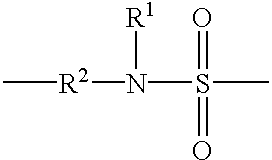Copolymer for cosmetics
a technology of copolymer and cosmetics, applied in the field of copolymer for cosmetics, can solve the problems of insufficient water resistance and water- and oil-repellency of conventional film forming agents, film is destroyed, and the messy makeup caused by skin fat cannot be prevented
- Summary
- Abstract
- Description
- Claims
- Application Information
AI Technical Summary
Problems solved by technology
Method used
Image
Examples
example 5
Preparative Example 5
A solution of FA / HEMA (=6 / 4 wt.) copolymer in ethanol (20% by weight) was obtained by carrying out preparation in the same manner as in Preparative Example 4, except that PE-350 as the monomer was replaced by 2-hydroxyethyl methacrylate (HEMA).
example 6
Preparative Example 6
36 g of FA, 24 g of n-butyl acrylate (BA), 90 g of ion-exchanged water, 24 g of ethanol, 0.06 g of n-lauryl mercaptan, 1.8 g of sorbitan monolaurate and 4.2 g of polyoxyethylene octyl phenyl ether were mixed together and heated to 60.degree. C. Then, the mixture was emulsified using a high-pressure homogenizer. The emulsion thus obtained was placed in a four-neck flask fitted with a reflux condenser, tube for introduction of nitrogen, thermometer and stirrer. The reaction liquid was kept at 60.degree. C. under a nitrogen stream and sufficiently stirred. Then, the reaction liquid was added with 0.3 g of azobis(isobutylamidine) dihydrochloride (trade name V-50 manufactured by Wako Pure Chemical Industries, Ltd.) and polymerization was initiated. The polymerization was carried out by keeping the reaction liquid at 60.degree. C. for 3 hours with stirring to obtain a polymer emulsion. The polymerization percentage of FA was found to be 99% or more by analyzing the pr...
example 7
Preparative Example 7
An FA / SMA-MM (=2 / 8 wt.) copolymer was obtained by carrying out polymerization and separation in the same manner as in Preparative Example 1, except that 20 g of FA and 20 g of Si-MM as monomers were replaced by 8 g of FA and 32 g of stearyl methacrylate macromonomer: ##STR23##
[hereinafter abbreviated as "SMA-MM", trade name MM-8SMA (molecular weight: 9,000), manufactured by Toagosei Chemical Industry Co., Ltd.]. The FA / SMA-MM copolymer thus obtained was dissolved in isoparaffin so that the concentration of the copolymer in the solution was adjusted to 20% by weight. In this way, a solution of FA / SMA-MM copolymer in isoparaffin (20% by weight) was obtained.
PUM
| Property | Measurement | Unit |
|---|---|---|
| Percent by mass | aaaaa | aaaaa |
| Percent by mass | aaaaa | aaaaa |
| Percent by mass | aaaaa | aaaaa |
Abstract
Description
Claims
Application Information
 Login to View More
Login to View More - R&D
- Intellectual Property
- Life Sciences
- Materials
- Tech Scout
- Unparalleled Data Quality
- Higher Quality Content
- 60% Fewer Hallucinations
Browse by: Latest US Patents, China's latest patents, Technical Efficacy Thesaurus, Application Domain, Technology Topic, Popular Technical Reports.
© 2025 PatSnap. All rights reserved.Legal|Privacy policy|Modern Slavery Act Transparency Statement|Sitemap|About US| Contact US: help@patsnap.com



